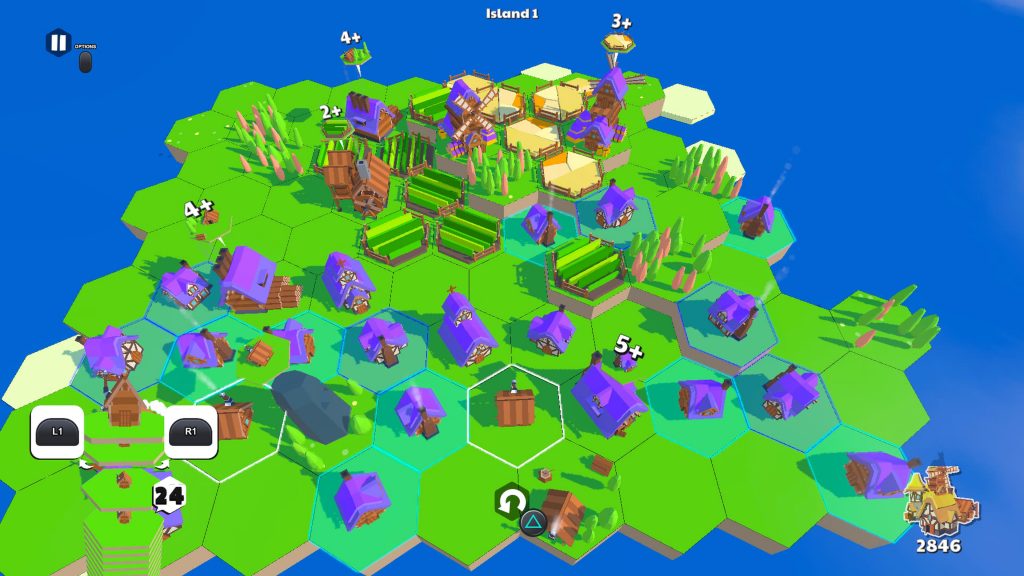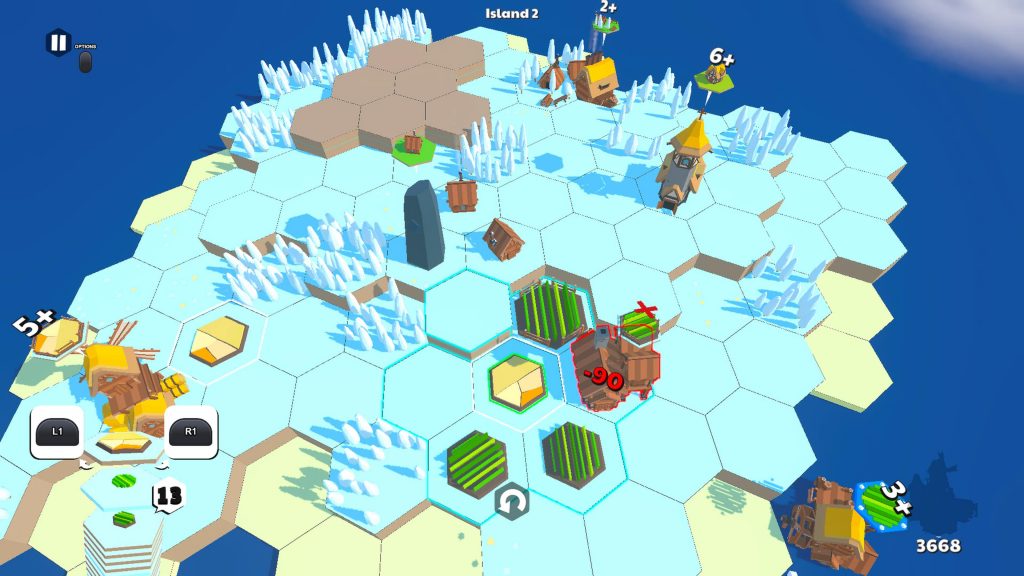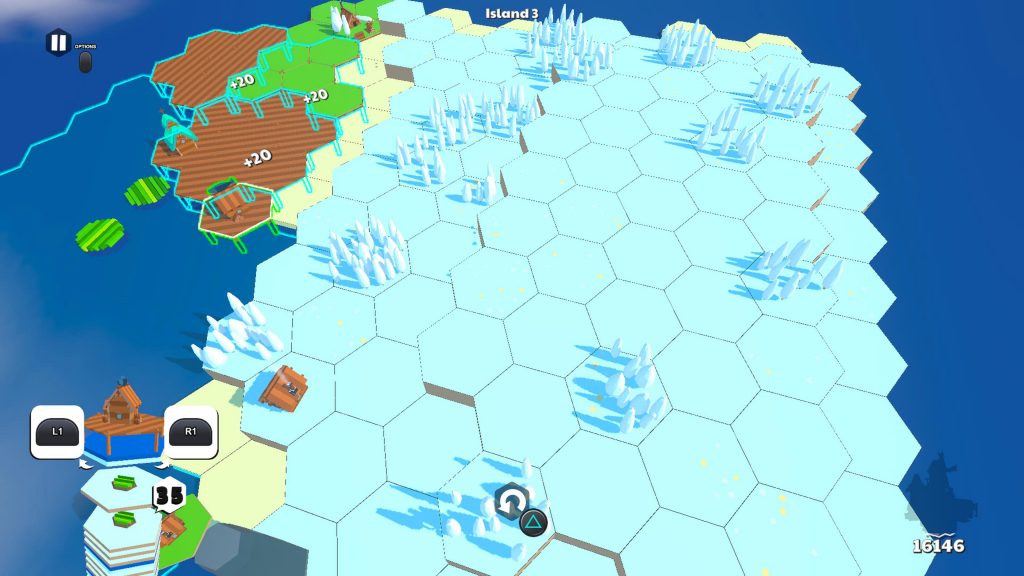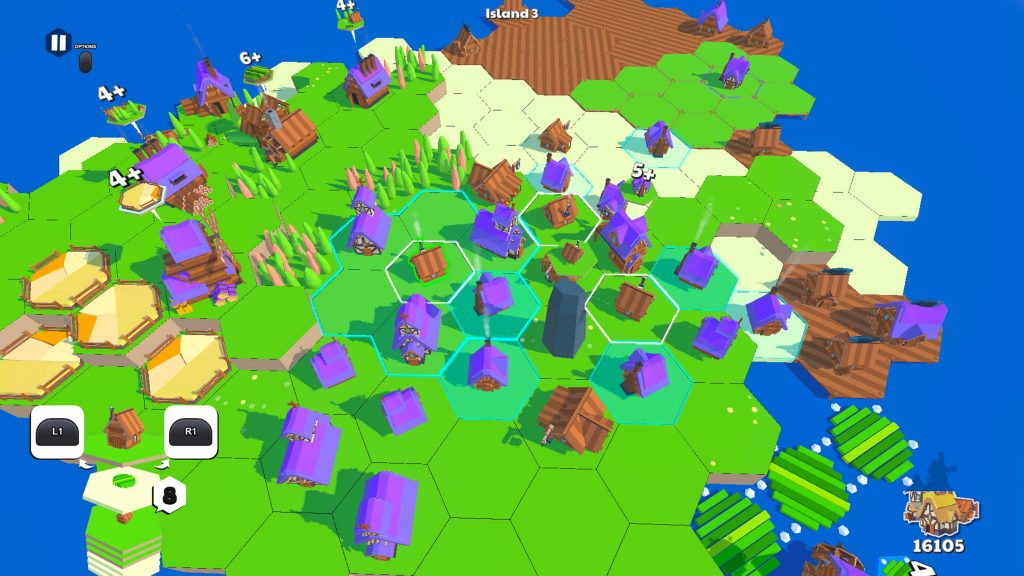Match Village is a minimalist puzzle game that combines a sort of chilled-out city building set up but with a match three element and it comes to us from Brazil-based solo dev Moraes Game Studio. It’s currently on PSN for a penny under four quid and it has been published by QUByte Interactive.
Before we get into the mechanics, Match Village opens in a very strange way. With a sort of disclaimer/apology from the developer that states “Welcome to Match Village! Here you’ll combine buildings to create villages on infinite islands generated by the game. Don’t expect a AAA experience, this was developed by just one guy, but I promise you’ll have a fun and satisfying experience.”
 Now, we review a lot of indie games here, many of which are from solo developers but we’ve never had one open with that kind of statement before. It’s an odd opening gambit. But we have some fondness for this specific type of game and so we set our expectations accordingly.
Now, we review a lot of indie games here, many of which are from solo developers but we’ve never had one open with that kind of statement before. It’s an odd opening gambit. But we have some fondness for this specific type of game and so we set our expectations accordingly.
As the statement says, each level of Match Village is set on an island but beyond that the game doesn’t offer any kind of tutorial and instead you are just thrown into the action. The core mechanics are pretty easy to grasp though. You have a stack of tiles, each one representing a building that you can create. If you place three of the same tile next to each other, they’ll combine into a slightly improved version of that building (or farm or whatever the tile is). The trick to success is to then combine those improved units and so on, generating points every time you make a match.
 This process also earns you additional tiles, which is important because the only condition for failure is to run out of tiles. So if you just place them all without making matches, you won’t see your way past the first level. However, if you hit the required points total you can then choose to leave the island and continue your progress (and score) on the next one. It’s essentially a mix of Triple Town (the genre’s grandaddy and the inspiration for the wildly popular 2048) mixed with elements of Dorfromantik and Islanders (which we reviewed back in 2021 and liked a lot).
This process also earns you additional tiles, which is important because the only condition for failure is to run out of tiles. So if you just place them all without making matches, you won’t see your way past the first level. However, if you hit the required points total you can then choose to leave the island and continue your progress (and score) on the next one. It’s essentially a mix of Triple Town (the genre’s grandaddy and the inspiration for the wildly popular 2048) mixed with elements of Dorfromantik and Islanders (which we reviewed back in 2021 and liked a lot).
Each successive island adds new tile types such a water-based units which adds a little to the complexity but generally the game’s progression is pretty gentle. So, once you figure out what you’re doing, you’ll generally be fine and then it’s just a case of pressing on until you run out of tiles. A leaderboard (and, of course, the game’s trophy list) should keep you interested. We love that there’s a leaderboard there but, oddly, it only shows the top ten players, so you’re pretty much just limited to chasing the very best players.
The setting and the core mechanics are exactly the sort of thing that we tend to like. However, Match Village has quite a few issues that did conspire to spoil things quite a bit. They’re all fixable though and so hopefully the developer will work on them, but they’re also not necessarily a budget issue but rather just what happens when you don’t have a team questioning each other’s design choices.
Our main issue was with the readability of the screen. Triple Town was a top-down 2D affair which had the advantage of everything being very easy to read. Here though the various units all look quite similar. We’ve evolved houses four times and the first three variants all look very similar. And then you’ve got the same thing with churches. Oh, and the churches and houses are all yellow which doesn’t help. Also, there’s no zoom on the camera which makes it even harder to check. But then things get worse because other buildings such as markets and breweries also look the same as the houses.
In fact there’s no panning either, so when you get to Island 3, you’ll really have a problem because the game introduces platforms that you can place in the water, but that’s right on the edge of your view and so you’ll end up fighting with the rotation of the camera to get a decent viewpoint, which you’ll never achieve. It just doesn’t work very well. And you can’t zoom (why even use 3D visuals if you can’t do that?!) which is a shame because that would have helped if you wanted to check on what buildings you’ve got in play. Oh and sometimes your cursor just disappears which is fixable by pausing the game and resuming. It’s not a great look though.
The visuals aren’t helped either by the low quality of the graphics. We’ve played plenty of hex-based games that use 3D and they’ve always managed to look okay but this game has some of the roughest jaggies we’ve seen since the early days of the PS2. There’s seemingly no anti-aliasing at all. So all the hexes look bad and the lack of detail on the units is made even worse. For a game that’s about relaxing, it was more frustrating than it should have been.
 If you do manage to get a good flow going though, this type of game usually delivers and for a while we were enjoying aspects of it. Matching up houses is probably the best bit, because then you really get into that Triple Town type of strategy where you’re trying to work out where your next combined unit will end up. There’s a real puzzle-y element to it and that’s fine. The problem though is all the other units. Eventually, they stop combining. So for example you can combine three fields into a… er… bigger field… and if you combine those again, you’ll get a building on there. Great. But then the bigger fields around it stop combining. You’ll likely get enough points to progress and so that’s fine but if you really want to max out on score, it becomes a hindrance. Although after a while a lot of the other tiles stop getting produced and you’ll just have houses and fields. Now, maybe we’re missing something, but there’s a weird inconsistency to the rules here and, of course, none of it is really explained.
If you do manage to get a good flow going though, this type of game usually delivers and for a while we were enjoying aspects of it. Matching up houses is probably the best bit, because then you really get into that Triple Town type of strategy where you’re trying to work out where your next combined unit will end up. There’s a real puzzle-y element to it and that’s fine. The problem though is all the other units. Eventually, they stop combining. So for example you can combine three fields into a… er… bigger field… and if you combine those again, you’ll get a building on there. Great. But then the bigger fields around it stop combining. You’ll likely get enough points to progress and so that’s fine but if you really want to max out on score, it becomes a hindrance. Although after a while a lot of the other tiles stop getting produced and you’ll just have houses and fields. Now, maybe we’re missing something, but there’s a weird inconsistency to the rules here and, of course, none of it is really explained.
 Essentially though each level ends up being about placing different types of tile away from each other and leaving enough room to combine as many houses as possible. Which is okay but does get repetitive after a while anyway. There are ‘quests’ (apparently that’s what they are called, not that the game tells you) which require you to build a number of one type of building around another, and that can be quite fun to do, but beyond that there’s no real variation.
Essentially though each level ends up being about placing different types of tile away from each other and leaving enough room to combine as many houses as possible. Which is okay but does get repetitive after a while anyway. There are ‘quests’ (apparently that’s what they are called, not that the game tells you) which require you to build a number of one type of building around another, and that can be quite fun to do, but beyond that there’s no real variation.
For us, we’d definitely have used colour better to differentiate unit types. We’d have made the objectives a lot clearer. We’d have released the camera so that it helps rather than hinders. And we’d have done something about the game’s main menu which is pretty poorly designed (it’s like a mobile game design but sort of nonsensical). But, equally, we’re not games developers and couldn’t make something like this if we had ten years and our lives depended on it. Still, it seems like most of the game’s issues could have been solved with stronger playtesting. And, honestly, we feel like dicks for even complaining this much but a game’s either got it or it hasn’t and Match Village just hasn’t.
+ No time limits to put pressure on you
+ Online leaderboard is a nice addition
+ Poorly designed units
+ Inflexible camera
+ Poor UI

